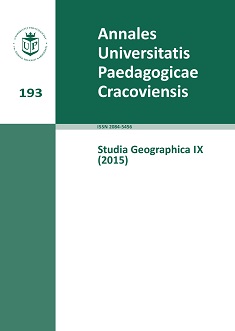Selected features of socio-demographic structure of a postmilitary town that emerged after the decommissioning of the Soviet Army’s secret military base in Poland – the Borne Sulinowo example
Keywords:
closed cities, garrisons, military bases, post-military areasAbstract
The goal of the paper was to present the selected socio-demographic features of Borne Sulinowo, a unique town in Poland, established within the area of the former secret military base of the Soviet Army and never used for non-military purposes before 1993. Borne Sulinowo is located in the north-west, approx. 20 kilometres from Szczecinek town. Before the World War II it had been a German garrison with the Wehrmacht Artillery School and after 1945 the area was taken over by the Soviet Army. The troops were present there until the end of 1992. Once the Soviet soldiers and officers have left the garrison, new Polish inhabitants started to come to Borne Sulinowo and develop the “new” town. That is why the socio-demographic structure of the town in its first 20 years (1993-2013) was peculiar, and so were the factors determining its transformation. The influence of the military past on the structure of Borne Sulinowo population has been shown in the paper. In 2013 the population of Borne Sulinowo consisted of approximately 4900 people; 60% of whom were between 18 and 59 years old. People under 18 made up 18% of the total population, whilst inhabitants over 60-22%. Because of the short Polish history of the town and the lack of traditions, Borne Sulinowo’s citizens are not fully integrated. Most of them came from different regions of Poland, thus having various backgrounds and cultures.References
Biały, A. (1993). Borne Sulinowo bez tajemnic. Powrót miasta. Gazeta Wyborcza, 13, 10.
Dom Pomocy Społecznej w Bornem Sulinowie (2015, 4 stycznia). Retrieved from: http://www.dps.dpsborne.eu
Gawryś, F. (1996). Czy Borne umrze śmiercią naturalną? Krótka historia leśnego miasta. Rzeczpospolita, 150, 6.
Główny Urząd Statystyczny (2015, 25 stycznia). Retrieved from: http://www. stat.gov.pl
Krogulski, M. (2001). Okupacja w imię sojuszu. Armia Radziecka w Polsce 1956–1993. Warszawa: Wydawnictwo von Borowiecky.
Łazarewicz, C., Sztyler, A. (1993). Borne dla bogaczy. Gazeta Wyborcza Koszalin, 187, 5.
Małachowski, K., Szymańska, D. (1995). Borne Sulinowo u progu swego rozwoju. Czasopismo Geograficzne, 66, 61–68.
Ostrowski, Z., Szczepański, M. (1992). Pożegnanie z armią. Warszawa: Czytelnik.
Pawlak, W. (2012). Borne Sulinowo – miasto trzech kultur. Plan miasta w skali 1:4500. Borne Sulinowo: Biuro Geodezyjno-Kartograficzne Waldemar Pawlak.
Płoskoń, A. (2014). Wybrane cechy społeczno-demograficzne Bornego Sulinowa jako miasta powstałego po likwidacji tajnej bazy wojsk Armii Radzieckiej. In: A. Zborowski (ed.), Człowiek – Społeczeństwo – Przestrzeń. Kraków-Myczkowce: Instytut Geografii i Gospodarki Przestrzennej UJ, Centrum Kultury Ekumenicznej, 51-66.
Skowronek, T. (2014). Zapomniane igrzyska. Borne Sulinowo – fakty i legendy, 2, 3–24.
Strategia rozwoju miasta i gminy Borne Sulinowo na lata 2004–2019. (2003). Borne Sulinowo: Urząd Miasta i Gminy Borne Sulinowo.
Strategia rozwoju turystyki w gminie Borne Sulinowo na lata 2009–2015. (2009). Borne Sulinowo: Urząd Miasta i Gminy Borne Sulinowo.
Szymański, B. (2009, 5 stycznia). Ostateczne wycofanie wojsk radzieckich z Polski. Retrieved from: http://tematy.wiadomosci.gazeta.pl/wiadomosci/ostateczne+wycofanie
Urząd Miejski w Bornem Sulinowie (2015, 25 stycznia). Retrieved from: http://www. bornesulinowo.pl
Downloads
Published
Issue
Section
License
The submission of a paper to be published is synonymous with an agreement to transfer the copyright free of charge from the author to the publisher. The author also agrees to permit the publisher to publish the paper in printed form, open access online form, digital library form and other digital platforms with which the publisher has or will have a publishing agreement. Furthermore, the author agrees to not limit the number of copies that may be printed or issued by the publisher. In the case of co-authored papers, it is assumed that the corresponding author is authorized to represent the remaining co-authors in this respect. Authors are requested to sign a copyright declaration.

